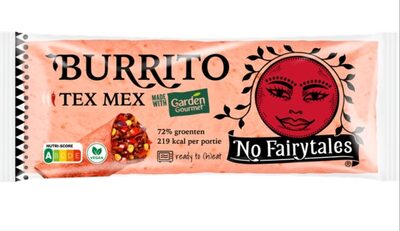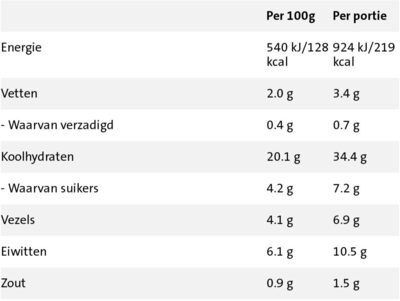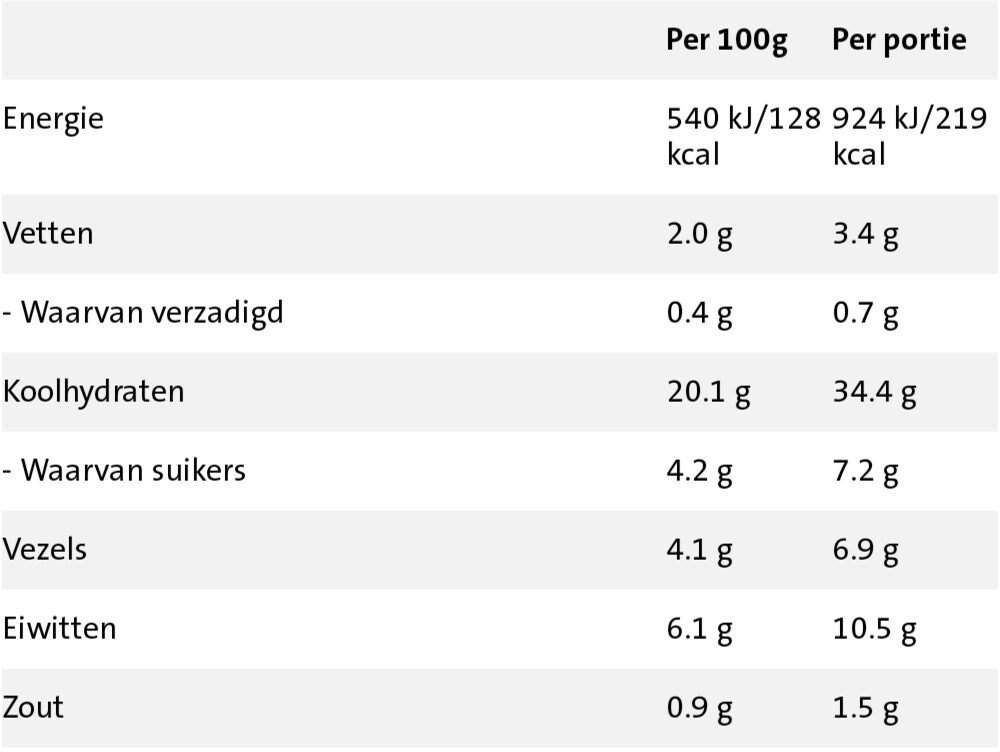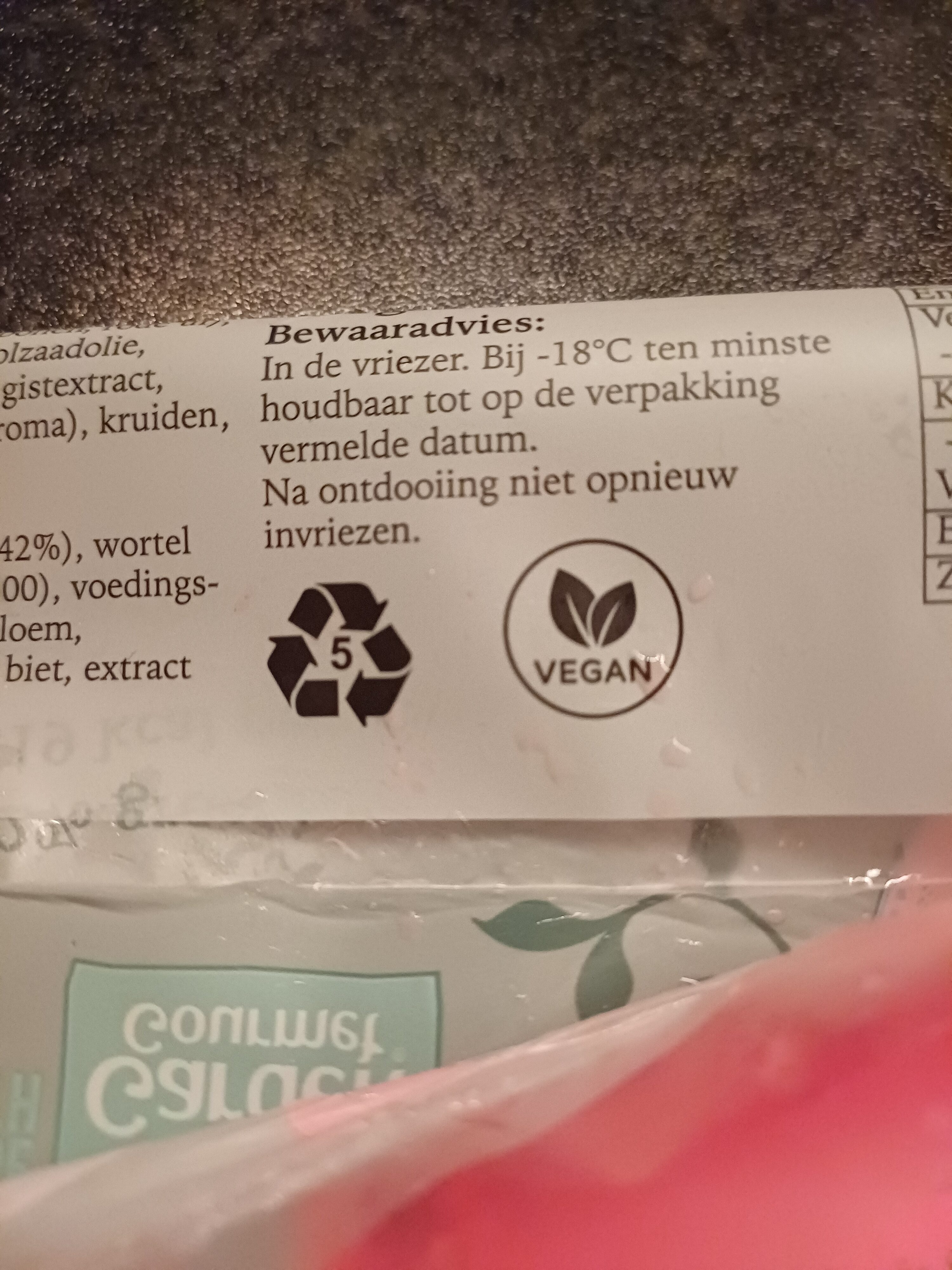Help us make food transparency the norm!
As a non-profit organization, we depend on your donations to continue informing consumers around the world about what they eat.
The food revolution starts with you!
Burrito texmex - No fairytales - 171 gram
Burrito texmex - No fairytales - 171 gram
This product page is not complete. You can help to complete it by editing it and adding more data from the photos we have, or by taking more photos using the app for Android or iPhone/iPad. Thank you!
×
Barcode: 8720618765529 (EAN / EAN-13)
Quantity: 171 gram
Brands: No fairytales
Categories: Snacks, Frozen foods, Meals, Sandwiches, Refrigerated foods, Wraps, Frozen ready-made meals, Refrigerated meals, Vegetarian wraps
Labels, certifications, awards: Vegetarian, Vegan, Nutriscore, Nutriscore Grade A
Origin of ingredients: Netherlands
Countries where sold: Netherlands
Matching with your preferences
Health
Ingredients
-
43 ingredients
Dutch: • Vulling (65%): groenten (rode paprika, mais, kidneybonen, rode ui), tomatenpuree, vegan gehakt (gerehydrateerd soja-meel (91%), koolzaadolie, gerehydrateerd tarwe-eiwit (2,2%), gerstemoutextract, gistextract, kruiden, specerijen, zout, gedroogde gebakken ui (ui, koolzaadolie), aroma), kruiden, specerijen. • Tomatentortilla (35% ) : tarwebloem, groenten (45%): tomaat (42%), wortel (3%), glycerol, tarwe-eiwit, raapzaadolie, rijsmiddelen (E450, E500), voedingszuur (appelzuur, ascorbinezuur), emulgatoren (E415, E472e), linzenbloem, conserveermiddel (E202), knoflookpoeder, zout, concentraat van rode biet, extract van paprika, kleurstof (bètacaroteen).Allergens: Gluten
Food processing
-
Ultra processed foods
Elements that indicate the product is in the 4 - Ultra processed food and drink products group:
- Additive: E160a - Carotene
- Additive: E415 - Xanthan gum
- Additive: E422 - Glycerol
- Additive: E450 - Diphosphates
- Additive: E472e - Mono- and diacetyltartaric acid esters of mono- and diglycerides of fatty acids
- Ingredient: Colour
- Ingredient: Emulsifier
- Ingredient: Flavouring
Food products are classified into 4 groups according to their degree of processing:
- Unprocessed or minimally processed foods
- Processed culinary ingredients
- Processed foods
- Ultra processed foods
The determination of the group is based on the category of the product and on the ingredients it contains.
Additives
-
E160a - Carotene
Carotene: The term carotene -also carotin, from the Latin carota, "carrot"- is used for many related unsaturated hydrocarbon substances having the formula C40Hx, which are synthesized by plants but in general cannot be made by animals -with the exception of some aphids and spider mites which acquired the synthesizing genes from fungi-. Carotenes are photosynthetic pigments important for photosynthesis. Carotenes contain no oxygen atoms. They absorb ultraviolet, violet, and blue light and scatter orange or red light, and -in low concentrations- yellow light. Carotenes are responsible for the orange colour of the carrot, for which this class of chemicals is named, and for the colours of many other fruits, vegetables and fungi -for example, sweet potatoes, chanterelle and orange cantaloupe melon-. Carotenes are also responsible for the orange -but not all of the yellow- colours in dry foliage. They also -in lower concentrations- impart the yellow coloration to milk-fat and butter. Omnivorous animal species which are relatively poor converters of coloured dietary carotenoids to colourless retinoids have yellowed-coloured body fat, as a result of the carotenoid retention from the vegetable portion of their diet. The typical yellow-coloured fat of humans and chickens is a result of fat storage of carotenes from their diets. Carotenes contribute to photosynthesis by transmitting the light energy they absorb to chlorophyll. They also protect plant tissues by helping to absorb the energy from singlet oxygen, an excited form of the oxygen molecule O2 which is formed during photosynthesis. β-Carotene is composed of two retinyl groups, and is broken down in the mucosa of the human small intestine by β-carotene 15‚15'-monooxygenase to retinal, a form of vitamin A. β-Carotene can be stored in the liver and body fat and converted to retinal as needed, thus making it a form of vitamin A for humans and some other mammals. The carotenes α-carotene and γ-carotene, due to their single retinyl group -β-ionone ring-, also have some vitamin A activity -though less than β-carotene-, as does the xanthophyll carotenoid β-cryptoxanthin. All other carotenoids, including lycopene, have no beta-ring and thus no vitamin A activity -although they may have antioxidant activity and thus biological activity in other ways-. Animal species differ greatly in their ability to convert retinyl -beta-ionone- containing carotenoids to retinals. Carnivores in general are poor converters of dietary ionone-containing carotenoids. Pure carnivores such as ferrets lack β-carotene 15‚15'-monooxygenase and cannot convert any carotenoids to retinals at all -resulting in carotenes not being a form of vitamin A for this species-; while cats can convert a trace of β-carotene to retinol, although the amount is totally insufficient for meeting their daily retinol needs.Source: Wikipedia
-
E160ai - Beta-carotene
Beta-Carotene: β-Carotene is an organic, strongly colored red-orange pigment abundant in plants and fruits. It is a member of the carotenes, which are terpenoids -isoprenoids-, synthesized biochemically from eight isoprene units and thus having 40 carbons. Among the carotenes, β-carotene is distinguished by having beta-rings at both ends of the molecule. β-Carotene is biosynthesized from geranylgeranyl pyrophosphate.β-Carotene is the most common form of carotene in plants. When used as a food coloring, it has the E number E160a. The structure was deduced by Karrer et al. in 1930. In nature, β-carotene is a precursor -inactive form- to vitamin A via the action of beta-carotene 15‚15'-monooxygenase.Isolation of β-carotene from fruits abundant in carotenoids is commonly done using column chromatography. It can also be extracted from the beta-carotene rich algae, Dunaliella salina. The separation of β-carotene from the mixture of other carotenoids is based on the polarity of a compound. β-Carotene is a non-polar compound, so it is separated with a non-polar solvent such as hexane. Being highly conjugated, it is deeply colored, and as a hydrocarbon lacking functional groups, it is very lipophilic.Source: Wikipedia
-
E202 - Potassium sorbate
Potassium sorbate (E202) is a synthetic food preservative commonly used to extend the shelf life of various food products.
It works by inhibiting the growth of molds, yeast, and some bacteria, preventing spoilage. When added to foods, it helps maintain their freshness and quality.
Some studies have shown that when combined with nitrites, potassium sorbate have genotoxic activity in vitro. However, potassium sorbate is generally recognized as safe (GRAS) by regulatory authorities.
-
E296 - Malic acid
Malic acid: Malic acid is an organic compound with the molecular formula C4H6O5. It is a dicarboxylic acid that is made by all living organisms, contributes to the pleasantly sour taste of fruits, and is used as a food additive. Malic acid has two stereoisomeric forms -L- and D-enantiomers-, though only the L-isomer exists naturally. The salts and esters of malic acid are known as malates. The malate anion is an intermediate in the citric acid cycle.Source: Wikipedia
-
E415 - Xanthan gum
Xanthan gum (E415) is a natural polysaccharide derived from fermented sugars, often used in the food industry as a thickening and stabilizing agent.
This versatile food additive enhances texture and prevents ingredient separation in a wide range of products, including salad dressings, sauces, and gluten-free baked goods.
It is considered safe for consumption even at high intake amounts.
-
E422 - Glycerol
Glycerol: Glycerol -; also called glycerine or glycerin; see spelling differences- is a simple polyol compound. It is a colorless, odorless, viscous liquid that is sweet-tasting and non-toxic. The glycerol backbone is found in all lipids known as triglycerides. It is widely used in the food industry as a sweetener and humectant and in pharmaceutical formulations. Glycerol has three hydroxyl groups that are responsible for its solubility in water and its hygroscopic nature.Source: Wikipedia
-
E450 - Diphosphates
Diphosphates (E450) are food additives often utilized to modify the texture of products, acting as leavening agents in baking and preventing the coagulation of canned food.
These salts can stabilize whipped cream and are also found in powdered products to maintain their flow properties. They are commonly present in baked goods, processed meats, and soft drinks.
Derived from phosphoric acid, they're part of our daily phosphate intake, which often surpasses recommended levels due to the prevalence of phosphates in processed foods and drinks.
Excessive phosphate consumption is linked to health issues, such as impaired kidney function and weakened bone health. Though diphosphates are generally regarded as safe when consumed within established acceptable daily intakes, it's imperative to monitor overall phosphate consumption to maintain optimal health.
-
E500 - Sodium carbonates
Sodium carbonates (E500) are compounds commonly used in food preparation as leavening agents, helping baked goods rise by releasing carbon dioxide when they interact with acids.
Often found in baking soda, they regulate the pH of food, preventing it from becoming too acidic or too alkaline. In the culinary world, sodium carbonates can also enhance the texture and structure of foods, such as noodles, by modifying the gluten network.
Generally recognized as safe, sodium carbonates are non-toxic when consumed in typical amounts found in food.
Ingredients analysis
-
May contain palm oil
Ingredients that may contain palm oil: E472e, E160ai
-
Vegan
No non-vegan ingredients
Unrecognized ingredients: nl:vegan-gehakt, nl:gerehydrateerd-soja-meelSome ingredients could not be recognized.
We need your help!
You can help us recognize more ingredients and better analyze the list of ingredients for this product and others:
- Edit this product page to correct spelling mistakes in the ingredients list, and/or to remove ingredients in other languages and sentences that are not related to the ingredients.
- Add new entries, synonyms or translations to our multilingual lists of ingredients, ingredient processing methods, and labels.
If you would like to help, join the #ingredients channel on our Slack discussion space and/or learn about ingredients analysis on our wiki. Thank you!
-
Vegetarian
No non-vegetarian ingredients detected
Unrecognized ingredients: nl:vegan-gehakt, nl:gerehydrateerd-soja-meelSome ingredients could not be recognized.
We need your help!
You can help us recognize more ingredients and better analyze the list of ingredients for this product and others:
- Edit this product page to correct spelling mistakes in the ingredients list, and/or to remove ingredients in other languages and sentences that are not related to the ingredients.
- Add new entries, synonyms or translations to our multilingual lists of ingredients, ingredient processing methods, and labels.
If you would like to help, join the #ingredients channel on our Slack discussion space and/or learn about ingredients analysis on our wiki. Thank you!
-
Details of the analysis of the ingredients
We need your help!
Some ingredients could not be recognized.
We need your help!
You can help us recognize more ingredients and better analyze the list of ingredients for this product and others:
- Edit this product page to correct spelling mistakes in the ingredients list, and/or to remove ingredients in other languages and sentences that are not related to the ingredients.
- Add new entries, synonyms or translations to our multilingual lists of ingredients, ingredient processing methods, and labels.
If you would like to help, join the #ingredients channel on our Slack discussion space and/or learn about ingredients analysis on our wiki. Thank you!
nl: Vulling 65% (groenten, rode paprika), mais, rode ui, tomatenpuree, vegan gehakt (gerehydrateerd soja-meel 91%, koolzaadolie, gerehydrateerd tarwe-eiwit 2.2%, gerstemoutextract, gistextract, kruiden, specerijen, zout, aroma), kruiden, specerijen (tarwebloem), groenten 45% (tomaat 42%), wortel 3%, glycerol, tarwe-eiwit, raapzaadolie, rijsmiddelen (e450, e500), voedingszuur (appelzuur, ascorbinezuur), emulgatoren (e415, e472e), linzen, conserveermiddel (e202), knoflook, zout, van rode biet, van paprika, kleurstof (bètacaroteen)- Vulling -> en:filling - vegan: maybe - vegetarian: maybe - percent: 65
- groenten -> en:vegetable - vegan: yes - vegetarian: yes
- rode paprika -> en:red-bell-pepper - vegan: yes - vegetarian: yes - ciqual_food_code: 20087
- mais -> en:corn - vegan: yes - vegetarian: yes - ciqual_food_code: 9200
- rode ui -> en:red-onion - vegan: yes - vegetarian: yes - ciqual_food_code: 20034
- tomatenpuree -> en:tomato-puree - vegan: yes - vegetarian: yes - ciqual_food_code: 20170
- vegan gehakt -> nl:vegan-gehakt
- gerehydrateerd soja-meel -> nl:gerehydrateerd-soja-meel - percent: 91
- koolzaadolie -> en:colza-oil - vegan: yes - vegetarian: yes - from_palm_oil: no - ciqual_food_code: 17130
- gerehydrateerd tarwe-eiwit -> en:rehydrated-wheat-protein - vegan: yes - vegetarian: yes - percent: 2.2
- gerstemoutextract -> en:barley-malt-extract - vegan: yes - vegetarian: yes
- gistextract -> en:yeast-extract - vegan: yes - vegetarian: yes
- kruiden -> en:herb - vegan: yes - vegetarian: yes
- specerijen -> en:spice - vegan: yes - vegetarian: yes
- zout -> en:salt - vegan: yes - vegetarian: yes - ciqual_food_code: 11058
- aroma -> en:flavouring - vegan: maybe - vegetarian: maybe
- kruiden -> en:herb - vegan: yes - vegetarian: yes
- specerijen -> en:spice - vegan: yes - vegetarian: yes
- tarwebloem -> en:wheat-flour - vegan: yes - vegetarian: yes - ciqual_proxy_food_code: 9410
- groenten -> en:vegetable - vegan: yes - vegetarian: yes - percent: 45
- tomaat -> en:tomato - vegan: yes - vegetarian: yes - ciqual_food_code: 20047 - percent: 42
- wortel -> en:carrot - vegan: yes - vegetarian: yes - ciqual_food_code: 20009 - percent: 3
- glycerol -> en:e422 - vegan: maybe - vegetarian: maybe
- tarwe-eiwit -> en:wheat-protein - vegan: yes - vegetarian: yes
- raapzaadolie -> en:rapeseed-oil - vegan: yes - vegetarian: yes - from_palm_oil: no
- rijsmiddelen -> en:raising-agent
- e450 -> en:e450 - vegan: yes - vegetarian: yes
- e500 -> en:e500 - vegan: yes - vegetarian: yes
- voedingszuur -> en:acid
- appelzuur -> en:e296 - vegan: yes - vegetarian: yes
- ascorbinezuur -> en:e300 - vegan: yes - vegetarian: yes
- emulgatoren -> en:emulsifier
- e415 -> en:e415 - vegan: yes - vegetarian: yes
- e472e -> en:e472e - vegan: maybe - vegetarian: maybe - from_palm_oil: maybe
- linzen -> en:lentils - vegan: yes - vegetarian: yes - ciqual_food_code: 20505
- conserveermiddel -> en:preservative
- e202 -> en:e202 - vegan: yes - vegetarian: yes
- knoflook -> en:garlic - vegan: yes - vegetarian: yes - ciqual_food_code: 11000
- zout -> en:salt - vegan: yes - vegetarian: yes - ciqual_food_code: 11058
- van rode biet -> en:red-beetroot - vegan: yes - vegetarian: yes - ciqual_food_code: 20091
- van paprika -> en:spice-or-bell-pepper - vegan: yes - vegetarian: yes - ciqual_food_code: 20041
- kleurstof -> en:colour
- bètacaroteen -> en:e160ai - vegan: maybe - vegetarian: maybe - from_palm_oil: maybe
Nutrition
-
Very good nutritional quality
⚠ ️Warning: the amount of fruits, vegetables and nuts is not specified on the label, it was estimated from the list of ingredients: 126This product is not considered a beverage for the calculation of the Nutri-Score.
Positive points: 12
- Proteins: 3 / 5 (value: 6.1, rounded value: 6.1)
- Fiber: 4 / 5 (value: 4.1, rounded value: 4.1)
- Fruits, vegetables, nuts, and colza/walnut/olive oils: 5 / 5 (value: 126.125, rounded value: 126.1)
Negative points: 4
- Energy: 1 / 10 (value: 540, rounded value: 540)
- Sugars: 0 / 10 (value: 4.2, rounded value: 4.2)
- Saturated fat: 0 / 10 (value: 0.4, rounded value: 0.4)
- Sodium: 3 / 10 (value: 360, rounded value: 360)
The points for proteins are counted because the negative points are less than 11.
Nutritional score: (4 - 12)
Nutri-Score:
-
Nutrient levels
-
Fat in low quantity (2%)
What you need to know- A high consumption of fat, especially saturated fats, can raise cholesterol, which increases the risk of heart diseases.
Recommendation: Limit the consumption of fat and saturated fat- Choose products with lower fat and saturated fat content.
-
Saturated fat in low quantity (0.4%)
What you need to know- A high consumption of fat, especially saturated fats, can raise cholesterol, which increases the risk of heart diseases.
Recommendation: Limit the consumption of fat and saturated fat- Choose products with lower fat and saturated fat content.
-
Sugars in low quantity (4.2%)
What you need to know- A high consumption of sugar can cause weight gain and tooth decay. It also augments the risk of type 2 diabetes and cardio-vascular diseases.
Recommendation: Limit the consumption of sugar and sugary drinks- Sugary drinks (such as sodas, fruit beverages, and fruit juices and nectars) should be limited as much as possible (no more than 1 glass a day).
- Choose products with lower sugar content and reduce the consumption of products with added sugars.
-
Salt in moderate quantity (0.9%)
What you need to know- A high consumption of salt (or sodium) can cause raised blood pressure, which can increase the risk of heart disease and stroke.
- Many people who have high blood pressure do not know it, as there are often no symptoms.
- Most people consume too much salt (on average 9 to 12 grams per day), around twice the recommended maximum level of intake.
Recommendation: Limit the consumption of salt and salted food- Reduce the quantity of salt used when cooking, and don't salt again at the table.
- Limit the consumption of salty snacks and choose products with lower salt content.
-
-
Nutrition facts
Nutrition facts As sold
for 100 g / 100 mlAs sold
per serving (171 g)Compared to: Vegetarian wraps Energy 540 kj
(128 kcal)923 kj
(219 kcal)-45% Fat 2 g 3.42 g -75% Saturated fat 0.4 g 0.684 g -83% Carbohydrates 20.1 g 34.4 g -33% Sugars 4.2 g 7.18 g +44% Fiber 4.1 g 7.01 g +41% Proteins 6.1 g 10.4 g -8% Salt 0.9 g 1.54 g -3% Fruits‚ vegetables‚ nuts and rapeseed‚ walnut and olive oils (estimate from ingredients list analysis) 126.125 % 126.125 %
Environment
-
Eco-Score B - Low environmental impact
⚠ ️Select a country in order to include the full impact of transportation.The Eco-Score is an experimental score that summarizes the environmental impacts of food products.→ The Eco-Score was initially developped for France and it is being extended to other European countries. The Eco-Score formula is subject to change as it is regularly improved to make it more precise and better suited to each country.Life cycle analysis
-
Average impact of products of the same category: A (Score: 80/100)
Category: Wheat tortilla wrap, filled with soy-based, vegetarian
Category: Wheat tortilla wrap, filled with soy-based, vegetarian
- PEF environmental score: 0.28 (the lower the score, the lower the impact)
- including impact on climate change: 1.60 kg CO2 eq/kg of product
Stage Impact Agriculture
39.6 %Processing
34.4 %Packaging
4.1 %Transportation
6.3 %Distribution
3.3 %Consumption
12.3 %
Bonuses and maluses
-
Origins of ingredients with a medium impact
Bonus: +3
Environmental policy: +3
Transportation: 0
Origin of the product and/or its ingredients % of ingredients Impact Netherlands 100 %Medium
-
Packaging with a medium impact
Malus: -8
Shape Material Recycling Impact 1 Bag PP 5 - Polypropylene Recycle with plastics High
Eco-Score for this product
-
Impact for this product: B (Score: 75/100)
Product: Burrito texmex - No fairytales - 171 gram
Life cycle analysis score: 80
Sum of bonuses and maluses: -5
Final score: 75/100
-
Carbon footprint
-
Equal to driving 0.8 km in a petrol car
160 g CO² per 100g of product
The carbon emission figure comes from ADEME's Agribalyse database, for the category: Wheat tortilla wrap, filled with soy-based, vegetarian (Source: ADEME Agribalyse Database)
Stage Impact Agriculture
40.4 %Processing
30.9 %Packaging
7.1 %Transportation
13.4 %Distribution
2.3 %Consumption
5.8 %
Packaging
-
Packaging with a medium impact
-
Packaging parts
1 x Bag (PP 5 - Polypropylene)
-
Packaging materials
Material % Packaging weight Packaging weight per 100 g of product Plastic
-
Transportation
-
Origins of ingredients
Origins of ingredients with a medium impact
Origin of the product and/or its ingredients % of ingredients Impact Netherlands 100 %Medium
Report a problem
-
Incomplete or incorrect information?
Category, labels, ingredients, allergens, nutritional information, photos etc.
If the information does not match the information on the packaging, please complete or correct it. Open Food Facts is a collaborative database, and every contribution is useful for all.












